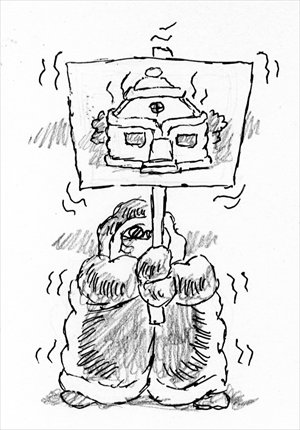It’s time we turned on the heat in southern China

Dozens of people who come from the southern parts of China have asked me the same question when they first met me: How can you northerners survive in winter? After getting to know each other better, the question is often replaced by a new one: As a northerner, why are you so afraid of cold in winter? I always answer that northern China's winters are, in a sense, much warmer than in southern parts due to the public heating service, which is commonly used throughout the bitterly cold winter in the north.
I was born in Harbin, Northeast China's Heilongjiang Province, where temperatures can drop to -30 C in winter. Several years ago, I traveled thousands of miles to attend college in Shanghai. Indoor temperatures in winter plunged from about 18 C to about 8 C. In every winter, I fantasized about a world where southern parts of China also had their own heating system.
Last year, I discovered that I wasn't the only one who felt this way. The question of whether there should be public heat in southern China has become quite a hot topic.
Zhang Xiaomei, a member of the National Committee of the Chinese People's Political Consultative Conference, submitted a proposal to extend public heat southward last year.
Voices in support of public heat in southern regions have become increasingly louder since then.
However, there are still many scholars who oppose such a measure. For instance, Shen Herong, chief engineer of equipment at Wuxi Architectural Design & Research Institute, says that southerners are already accustomed to a damp and cold environment, so public heating may make them uncomfortable. Shen's opinion has been mocked online.
Northern China used to not have public heating, but people living there are not likely to say they're unhappy with public heating because it makes them uncomfortable.
Also, the fact that people can survive in a cold environment does not mean they do not want more comfortable surroundings. We cannot stop making progress just because we can endure harsh conditions.
Moreover, indoor heating systems are becoming more efficient, which can help avoid wasting energy and provide the opportunity for every family to choose its level of comfort. Temperatures in provinces vary, and different families have different levels of tolerance to the cold. The growing number of voices calling for southern public heating reflects the fact that more people are demanding it.
Southern China is traditionally defined as everything south of the Qinling-Huai River. This line was drawn by Zhang Xiangwen, the first director of the Geographical Society of China, in 1908. After the People's Republic of China (PRC) was founded in 1949, the government used this as the dividing line for its plans for public heating due to limited economic development.
Today, 105 years have passed since the appearance of the dividing line at the Qinling-Huai River, and 64 years have gone by since the founding of the PRC. We are no longer a country in shambles. The traditional dividing line has to be adjusted to adapt to new changes.
The era is advancing, and we have to keep in step with the changes. After 30 years of reform and opening-up, present-day China's level of economic development is completely different from its early days. Currently, the Chinese government has the ability to let more people live in warm conditions in the winter. When it comes to people's quality of life, certain costs are necessary.
The author is a reporter with the Global Times. shumeng@globaltimes.com.cn